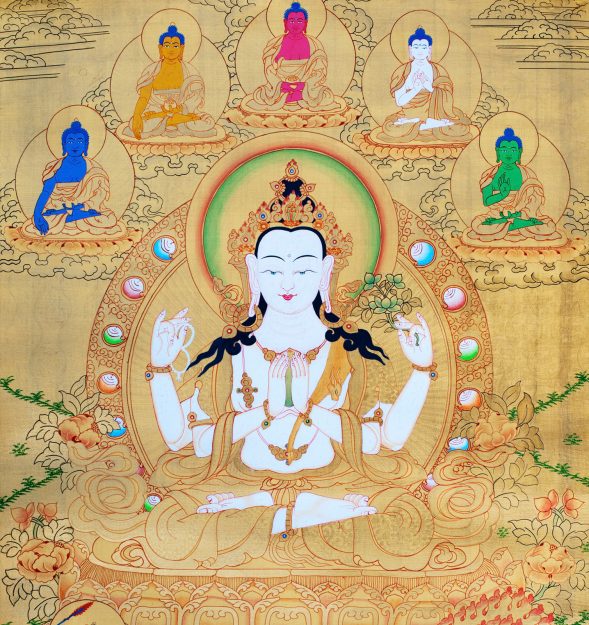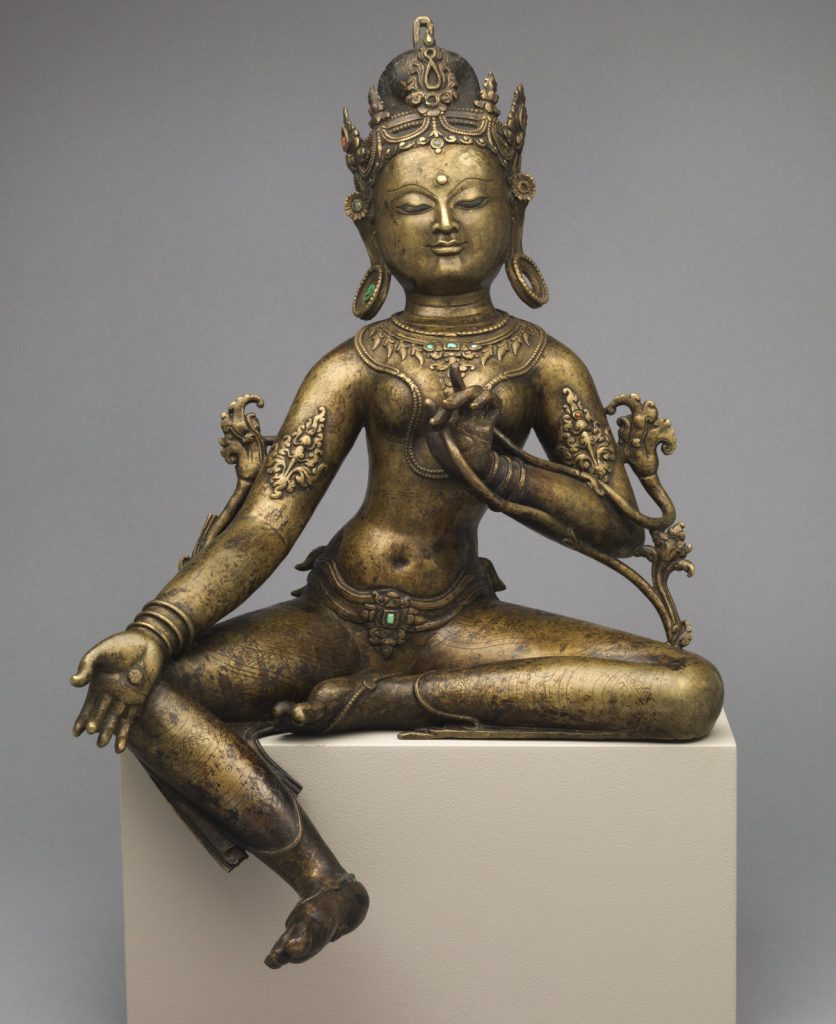The goddess Tara is perhaps the most universally cherished archetype of Tibetan Buddhism, a figure so beloved that she is called “Mother Tara” by her devotees. Also known as “the mother of all buddhas,” she is the embodiment of fully awakened wisdom and compassion who lovingly shepherds sentient beings from the endless suffering of samsara all the way to enlightenment. Most Tibetan monasteries and nunneries start their days with prayers to Tara in order to encourage success in—and remove obstacles to—the community’s spiritual and charitable undertakings. Practitioners also chant Tara’s mantra for healing during illness, success in business, safety during travel, and help overcoming any of life’s hurdles. More profoundly, meditating on Tara helps dharma practitioners navigate the impediments to spiritual realization known as the eight fears: attachment, arrogance, wrong view, jealousy, anger, doubt, greed or miserliness, and ignorance.
The devotion to Tara in Tibetan Buddhism is indicative of the tradition’s great reverence for motherhood. To develop the qualities of universal love and compassion, students of Tibetan Buddhism are often instructed to “regard all beings as though they are your mother” and to reflect on the discomfort their mothers selflessly endured during pregnancy and childbirth. Likewise, reciting the mantra and contemplating the enlightened qualities of Mother Tara are skillful methods for cultivating her boundless warmth, self-confidence, and capacity to help others. Just as attuned, healthy parenting helps children navigate life with resilience and purpose, Tara meditation provides dharma practitioners with the courage and strength to persevere on the spiritual path.
How are the adult children of harmful mothers supposed to relate to a practice like Tara meditation?
But what if the mother you had growing up was the opposite of loving and attentive—even downright harmful? Although there is certainly no such thing as a perfect mother, there are countless wonderful mothers in this world. But there are also those who, because of their own considerable traumatic wounding, repeatedly act in ways that are seriously neglectful, abusive, or even sadistic. Mothers do exist who get a kind of gratification from hurting their children. Moreover, many people are drawn to Buddhist practice because they experienced dysfunction in their families growing up and are hoping to heal their emotional injuries. How are the adult children of harmful mothers supposed to relate to a practice like Tara meditation?
For some adult survivors of childhood trauma, the affectionate, maternal imagery of Tara provides transformative comfort and healing—sometimes very quickly. Contemplating Tara can become a form of rapid reparenting where one is able to connect with mother-love in a way not previously experienced. Others have the opposite reaction: they wrestle with relating to Tara’s unconditional maternal love because they have no internal frame of reference for that particular energy. Rather than generating the warmth of feeling deeply understood, Buddhist practices related to motherhood may conjure the recurrent themes that children of harmful parents struggle with: a profound sense of worthlessness, core shame, and an almost unshakeable conviction that there is something wrong with them. Understandably, there can be a strong impulse to avoid these practices completely.
However, if you can push yourself a little, Tara practice can help replace your traumatized sense of self with a view that is more compassionate, humane, and accurate. You just need some special additional reflections to make the practice more accessible. The following suggestions are drawn from contemporary relational approaches to psychotherapy: you can experiment with them during traditional Tara meditation, if that is a practice you are familiar with, or integrate them in a more natural way by directing Tara’s gentle caring toward yourself in daily life. Everyone is different, and it’s important to discern what works best for you while gently setting aside what doesn’t.
What starts with self-transformation of personal trauma can end with the very purpose of the Buddhist path.
Grieve for what you needed and didn’t get.
Every sentient being deserves loving, attuned parents to give them what they need for healthy growth and development. If this did not happen for you, or if in fact what you received early in life from your parents was detrimental, you have experienced the loss of something very precious that needs to be fully grieved. Reflecting on what was lost and making space with gentleness and kindness for the range of reactions to having missed out—sadness, despair, guilt, anger, and jealousy toward those who have healthy parents—is a necessary part of the healing process. Grief can be explored in many different ways: by speaking with loved ones, certainly, but also by writing, making art, or using movement practices like dance or yoga, just to name a few. Certain kinds of deep grief are beyond verbal communication and demand forms of expression that are able to capture that wordless quality. Find what resonates for you.
Accept your feelings fully.
The feelings of worthlessness, shame, and self-criticism that you may have experienced at different moments in your life and that may even appear during meditation sessions are a manifestation of profound wounding. Children whose parents neglect or abuse them often unconsciously form the belief early on that they are bad or worthless. While this may occur as a direct result of being told that explicitly, it also happens for more subtle reasons. Children are totally dependent on their parents for their survival, so to take in the idea that there is something deeply wrong with their caregivers who are harming them is too threatening to a child’s basic sense of reality. Therefore, kids turn the blame on themselves—someone has to be at fault, and it can’t be their parents, so it must be them. When the feelings of self-blame first arose, they were an inevitable and adaptive attempt at coping and staying sane. Understanding this and reminding yourself of it with compassion every time those feelings arise can help them dissolve naturally over time.
Bring your distress into meditation.
If you have feelings of grief or self-criticism that arise during meditation, rather than treat them as an obstacle, welcome them in and make them the object of your meditation until they naturally melt away. Fully feel the sensations that arise in your physical body along with emotions, witness the form that your painful thoughts take, and definitely allow tears to flow if the urge to cry surfaces. Really give yourself the opportunity to experience all of your emotions as they rise. If you have been taught Tara’s visualization and mantra, treat your distress as a precious offering you are making to her and ask for her help to heal and transform it.
Find Tara figures in your life.
Although Tara is a female bodhisattva, her energy can be present in sentient beings regardless of gender. What people in your life help you feel supported, understood, and cared for? Perhaps there are friends or other family members, or maybe you are working with a therapist or another kind of healing practitioner. You may have more Taras around you than you realize. Maybe you’ve even had brief encounters in which you’ve been the recipient of random acts of kindness from strangers that were imbued with that gentle compassion. By bringing conscious awareness to those relationships and moments by remembering them and reflecting on them, you imprint that nurturing love more deeply in your mindstream. If you don’t have enough Tara energy in your life, consider working with a therapist to intentionally cultivate more supportive relationships.
Whether you try out these reflections in meditation or in your daily life, approach them with a spirit of openness, kindness, and concern, and you will subtly begin to embody Tara. As your capacity to treat yourself with gentleness and understanding grows, you may also find yourself offering that kindness to others more and more. In this way, you can move steadily, step by step, toward the ultimate spiritual realization of Tara: to become like her for the benefit of all sentient beings. What starts with self-transformation of personal trauma can end with the very purpose of the Buddhist path—developing the wisdom and compassion to care for everyone, without exception.

♦
Tara Facts
The name Tara literally means “savioress,” “she who liberates,” or “the one who brings us across.” Tara also means “star” and refers to her ability to respond as fast as a shooting star to anyone who calls for help.
Her mantra, “Om tare tuttare ture soha,” can be understood as “I prostrate to the Liberator, Mother of all the Victorious Ones.”
There are 21 forms of Tara, each with her own iconography that depicts different colors, ornaments, and symbolic hand gestures. This is because Tara is a shape-shifter who appears in the form most useful for the situation at hand. Of Tara’s many incarnations, the best known are Green Tara, who protects devotees from harm, and White Tara, who cures illness and bestows long life. There is a Tara to meet every conceivable need of sentient beings.
Tara was born from a tear shed by Avalokiteshvara, the bodhisattva of compassion, as he sorrowfully surveyed the world. The teardrop filled the Tibetan valley that now holds the city of Lhasa and formed a lake. There, a lotus grew, and from that flower Tara emerged. (See Mayumi Oda’s Tara depictions in the portfolio.)
Thank you for subscribing to Tricycle! As a nonprofit, we depend on readers like you to keep Buddhist teachings and practices widely available.
